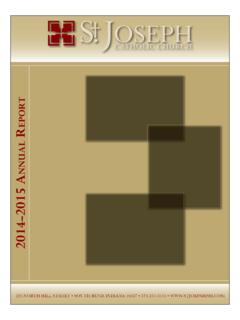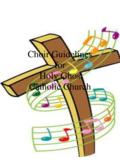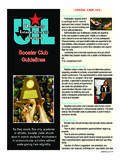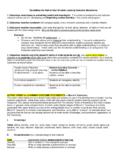Transcription of PRAYER OF THE FAITHFUL GUIDELINES - St. Joe Parish
1 PRAYER OF THE FAITHFUL GUIDELINES From the Director of music and Liturgy Writers of the PRAYER of the FAITHFUL exercise a most important ministry for the Parish community. Through these petitions, the writer becomes a voice for the FAITHFUL . The PRAYER of the FAITHFUL is both an act of faith in the triune God and a plea for God s intercession in the world. According to the General Instruction to the Roman Missal, in the PRAYER of the FAITHFUL , the people respond in some sense to the Word of God which they have received in faith and, exercising the office of their baptismal Priesthood, offer prayers to God for the salvation of all (GIRM #69).
2 The deeply spiritual goal of these prayers is to draw the FAITHFUL closer to God. Well-written prayers are a vessel to a deeper spiritual life of faith, and must be crafted with care. These GUIDELINES are intended to help you write prayers that are reverent, relevant, and readable, so that so that the FAITHFUL will not be distracted by them, but will enter into PRAYER through them. FORM The intentions are usually expressed in one of three forms: 1) The FULL FORM, that The full form announces who is to be prayed for and what is to be prayed for. Example: For all Christians, that they celebrate unity around the table of the Lord.
3 2) The PARTIAL FORM, The partial form mentions the favor to be requested, referring to the persons to be prayed for with one word. Example: That all Christians celebrate unity around the table of the Lord. 3) The SECOND PARTIAL FORM, The second partial form announces only those being prayed for. Example: For the unity of all Christians around the table of the Lord. One form should be used in a single set of petitions. For example, if the first petition begins with for, all the petitions for that liturgy should begin the same way. This lends unity to the prayers and allows the FAITHFUL to enter more freely into the PRAYER .
4 Remember that the petitions are not prayers of thanksgiving, but of petition for God s intercession. CONTENT Proceed from the general to the specific. Thus, the series of intentions is always: 1) for the needs of the universal church 2) for the public authorities and the salvation of the world 3) for those burdened by any kind of difficulty 4) for the local community There may be more than one petition from each of the above categories. 1) The needs of the universal church. This category includes petitions for the pope, bishops and pastors of the Church, missions, Christian unity, and vocations to the priesthood and religious life.
5 2) Public authorities and the salvation of the world. This category includes petitions for peace, leaders of government, elections, respect for the freedom of the Church, good weather, the safety of crops, and the resolution of economic crises. 3) People burdened by any kind of difficulty. This category includes those burdened by poverty or any other tribulation, the unborn, the persecuted, the unemployed, the sick and infirm, the dying, prisoners, and exiles, to name a few. 4) Local community. This category represents the local community of faith. People to pray for may include those in the church preparing for baptism, confirmation, Eucharist, holy orders, or marriage; it also includes prayers for the repose of the souls of the deceased.
6 This is where specific Parish needs should be communicated: for the upcoming Youth Mission Trip, for the success of the Capital Campaign, etc. 5) Silent prayers. At times offer the opportunity for the congregation to silently offer their private PRAYER . This final petition need only be offered every few weeks or months. Please write no less than five and no more than six petitions for liturgy. QUESTIONS FOR CONSIDERATION The intentions expressed in liturgy should be rooted in a time and place. Below are some questions to help spark your thoughts about the state of the church and the world, and their connection to living as a community of faith.
7 1. What are the themes of this Sunday s Scripture readings? What season of the liturgical year are we celebrating? 2. What are the noteworthy national or international news events of this week? 3. What challenges is the Church facing today? 4. What are some of the chronic problems we face at home, at work, in our local community, in our nation, 5. Are there special local events, national holidays, landmark date or anniversaries to be aware of this week? 6. Are there any specific Parish needs to address? 7. Who are the sick or deceased to remember in PRAYER this week? STYLE Strive to write petitions that are clear, concise, and to the point.
8 Be direct about who is addressed in the petition (For the newly ), and/or what action is desired (generally the Parish /community members acting with the Spirit). Write prose that is poetic but avoids excessive wordiness. Petitions tend to get heavy with extra clauses. Keep it simple, and avoid grandiose language. The petitions should be uplifting and inspirational for the community, drawing attention to the needs of all. Test the petitions you write by reading them aloud. The spoken word is received differently than the written word. While we write in our personal voice, these petitions are the voice of the Church universal and of the Parish community.
9 They are by necessity inclusive. Avoid including your own agenda in the petitions. PRACTICAL NOTES AND INSTRUCTIONS FOR WRITERS The PRAYER of the FAITHFUL begins with the presider s own invitation to pray as a community. The prayers contain petitions, not words of thanksgiving or praise. The response to PRAYER is usually signaled by the invitation to pray: Let us pray to the Lord. During special liturgical seasons this response may change. During Advent, Christmas, Lent and Easter, the invitation to pray is sung by the cantor and should not be included with the petitions.
10 Please include the following note for the lector at the bottom of the page containing the PRAYER of the FAITHFUL : At the conclusion of the petitions, please turn and face the presider. When he sits down, you may leave the ambo and return to your seat. Thank you for reading. The petitions are due two days before the liturgy you compose them for. They are due the Thursday before a Saturday liturgy, and two days before any feast day liturgy. Please email the completed petitions to the Pastor, Parochial Vicar, and Director of music and Liturgy. Communicate any scheduling questions to the PRAYER of the FAITHFUL Coordinator, Nicole Garnett The PRAYER of the FAITHFUL writers are scheduled by Nicole Garnett, and posted on the liturgical minister Web Terminal.









